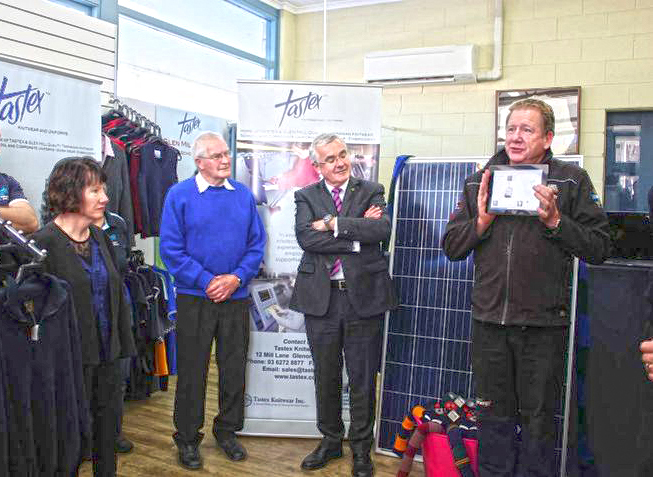A Tasmanian not-for-profit takes a leap where governments fear to tread.

Rob Manson of I Want Energy explains the finer points of solar power, watched by (left to right) Tastex executive officer Vicki Hawker, chairman Maurie Harris, and Andrew Wilkie MP, who launched the solar project last month. PHOTO Tastex
Repeated policy failures and a blinkered fixation on the bottom line have taught us that the top levels of government and business aren’t good at leading progressive change.
But don’t despair. Not-for-profit businesses and community groups are stepping into the breach. Here’s a story guaranteed to lift the spirits.
Tastex produces knitwear in a humble cement-block factory in Glenorchy. It’s a not-for-profit organisation that employs people with a disability who would otherwise be unable to work.
If you think that means relying on charity and government support, think again. Tastex has survived over 45 years in the cut-throat textile market and won international certification for the quality of its products and service. It didn’t do this by sitting back waiting for handouts.
An expanding customer base and product line (including novelty soft toys stuffed with unravelled woollen knitwear offcuts) attest to a lot of hard work by 25 staff under its fiercely dedicated executive officer Vicki Hawker. However you define “enterprising”, that’s Tastex.
But a long-running budgetary issue has had Tastex management stumped: the cost of electricity for its knitting, sewing and embroidery machines. The bill runs to around $14,000 a year.
Tastex board member Stuart Barry thought of solar panels on the factory’s large, flat roof, and sought the advice of Chris Harries, of the Waterworks Valley Community, and Jack Gilding, executive officer of the Tasmanian Renewable Energy Alliance.
Gilding estimated that the roof could accommodate enough panels to cut power bills in half. The company didn’t have the cash to pay for an installation, but Gilding put it in touch with someone who could help: Margaret Hender, founder and director of the Corena Fund.
Adelaide-based Corena (the name is the acronym for “Citizens Own Renewable Energy Network Australia”) is non-profit group which believes all Australian energy needs can and should be met from renewable sources.
Corena uses crowd-funding to raise money to distribute as interest-free loans to non-profit groups to install solar power or improve energy efficiency. Each project’s loan repayments are scaled so the borrower is ahead from day one, and repayments are recycled to the next project.
To reduce the size of its Corena loan, Tastex embarked on its own crowd-funding campaign, using the international fundraiser Chuffed.org, which charges no administrative fees for community and other not-for-profit groups.
The campaign was launched in mid-June by Denison MP Andrew Wilkie, who put up $500 to become its first donor. By last weekend it had raised about $13,000, over a third of the full cost of a 30-kilowatt rooftop system.
Among other benefactors is yet another non-profit group, Hobart-based Sustainable Living Tasmania, which has publicised the project among its many members.
Tastex still needs public support, but now the end is in sight. By next summer it will be using free solar power to offset energy bills and improve the company bottom line by $7000 a year
A visit to the Tastex factory last week convinced me that its good fortune didn’t happen by accident. This is a well led, highly motivated organisation that clearly thrives on creative thinking.
Importantly, it’s been able to draw on the energy and expertise of people willing and able to help at little or no cost – a wellspring of support that isn’t available for ordinary businesses and households. Which is where government needs to step in.
Full credit to the Hodgman government for its new scheme for interest-free loans to businesses and households installing solar panels and energy-efficient products. But it’s putting up only $10 million – a small fraction of what we paid for emergency diesel generation.
The government is falling into the trap of evaluating rooftop solar on the basis of its present scale, just 1 per cent of the state’s electricity generation, rather than where it could be with the right incentives. Experience elsewhere has shown how quickly that can change.
The strategic position would be to aim for household and business solar on a far bigger scale – eminently achievable if the feed-in tariff is based not on avoided costs to retailers, but on the long-term public benefit of distributed solar.
I can’t see that level of big-picture thinking happening, but I’d love to be proven wrong.
